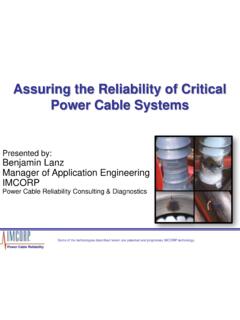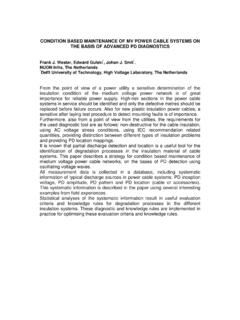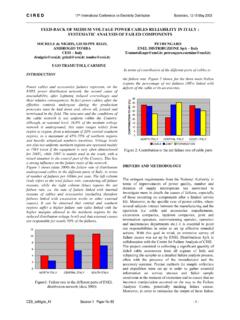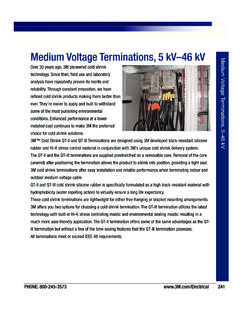Transcription of POWER CABLE - AVO Training
1 A NETA WORLD JOURNAL SPECIAL PUBLICATION | Training TALK | 7BY ALAN MARK FRANKS, AVO TrainingMuch has been said about the aging condition of POWER CABLE installa-tions in the United States. Cables can be categorized as service-aged solid dielectric, service-aged laminated (PILC), or cables of more recent design and installation. Much has been learned about the causes of CABLE outages, and recent studies indicate that even with design is-sues in early cables, the major cause of these outages can be related to poor quality during the installa-tion process, either in CABLE installation, termina-tion, or splicing.
2 The National Electric Energy Testing Research & Applications Center (NEETRAC) documents that approximately 50 percent of CABLE outages can be directly attributed to poor workmanship during CABLE installation, splicing, and terminating. As a result of the failure analysis studies conducted by NEETRAC, it can be concluded that there is a significant connection between CABLE outages and a lack of Training in CABLE installation, splicing, and terminating of medium-voltage cables. As well-stated in CABLE accessory failure analysis presented at the NEETRAC Fall 2010 ICC Educational Session: All evidence points to improved Training POWERCABLE OUTAGES AND THE Training CONNECTIONas the single most cost-effective means of improving system reliability.
3 Figure 1 represents the process of improving system reliability through failure analysis , Training , and skill 1: Improving CABLE System ReliabilityTracking leads to imminent CABLE failure and is caused by inadequate preparation and cleaning during the splicing process. failure ANALYSISF irst, consider the issue of failure analysis . A process of root cause should be employed to all CABLE outages to determine the primary cause of failure . If the failure is due to a product quality issue, the manufacturer is likely involved, and these types of issues normally include a significant timeline.
4 Redirection in purchasing and product approvals may be necessary to offset any further outages due to the use of the product. More often, the root cause can be identified as a workmanship issue, either in CABLE installation, splicing, or termination. Often, imminent CABLE failure is due to tracking caused by inadequate preparation and cleaning during the splicing process. This is one of the many common modes of failure experienced by utilities today. 8 | Training TALK | A NETA WORLD JOURNAL SPECIAL PUBLICATIONA nother example of improper CABLE preparation is where tool settings were not adequate for the semi-con stripping process, which will certainly result in many cases, the results of improper CABLE installation appear make it somewhat difficult to get to the bottom of what actually caused the initial failure .
5 With these issues in mind, it is imperative that a comprehensive CABLE failure analysis program be in place to determine root cause, thus ensuring that costly failures can be , preparation, splicing, and terminating are imparted to the worker. This is a craftsmanship issue that requires a detailed understanding of medium-voltage CABLE construction as well as the use of proper procedures and tools. Historically, these craft skills were taught in an on-the-job (OJT) fashion with apprentices working under the watchful eyes of skilled craftsmen who had years of CABLE experience.
6 These mentors grew up in the early stages of the CABLE industry and acquired their skills over a significant timeline that coincided with the boom of the POWER CABLE industry. As Baby Boomers are leaving the workplace, so are most of these mentors and, along with them, many years of CABLE splicing and terminating craft skills. OJT Training philosophies need to be supplemented with more formal Training with finite objectives and proctored labs where workers not only learn the technologies, but also the craft skills necessary to perform medium-voltage CABLE work.
7 The implementation of formal CABLE Training greatly reduces the time it would take to gain this experience on the job. By implementing formal Training , the quality of instruction can be monitored to ensure that all trainees get the same information and apply the knowledge in controlled lab exercises proctored by experienced instructors; this ensures that the mentorship is complete. The impact of high-quality Training where workers demonstrate the learned skills has a definite impact on the future quality of maintenance and new installation work.
8 Training can be outlined in four basic areas of craftsmanship: CABLE installation and handling CABLE preparation and tools CABLE splicing CABLE terminationCABLE INSTALLATION AND HANDLINGMany CABLE failures occur because of mishandling the CABLE during installation. Issues such as exceeding the bending radius, excessive tension, excessive side-wall pressure, cuts, abrasion, and damage to jacket etc. can lead to CABLE failure . Much of this damage goes unrecognized as many current acceptance testing methods will not identify the damage unless it is catastrophic in nature.
9 In Improper CABLE preparation leaves semi-conductive insulation shield material that will result in CABLE CABLE installation caused CABLE failure in a manhole analysis certainly will identify poor workmanship that leads to failure . Identifying these types of issues can provide invaluable insight concerning the Training of workers involved in installation, splicing, and termination of CABLE systems. TRAININGT raining certainly will have an impact on system reliability, provided that the proper skills in CABLE A NETA WORLD JOURNAL SPECIAL PUBLICATION | Training TALK | 9short, these damages go un-noticed sometimes for years and ultimately lead to failure and a premature shortening of CABLE handling, specifications, rigging, application of lubricants, conduit fill, etc.
10 Are necessary components of Training that installers need to ensure proper installation of medium-voltage cables. It often takes a significant amount of equipment and rigging to install POWER cables. do not provide explicit instructions on how to prepare the CABLE ; rather, the instructions specify the dimensions required in the preparation. Most manufacturers have a disclaimer that reads as follows: Prepare cables according to acceptable industry practices. Therein lies the ambiguity, as no specific guidelines are provided as to methods or tooling other than tool manufacturers instructions on how to use their specific vary widely in the and, in many cases, there are no specific requirements.










